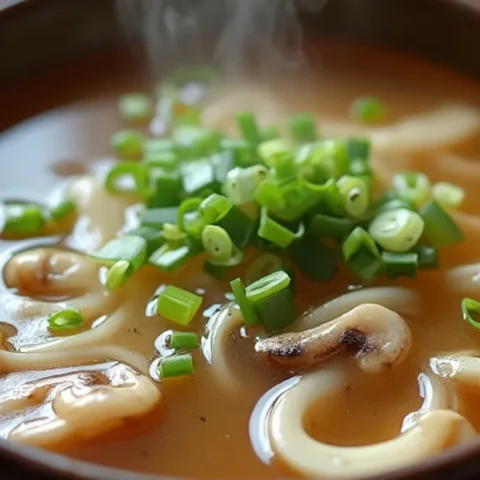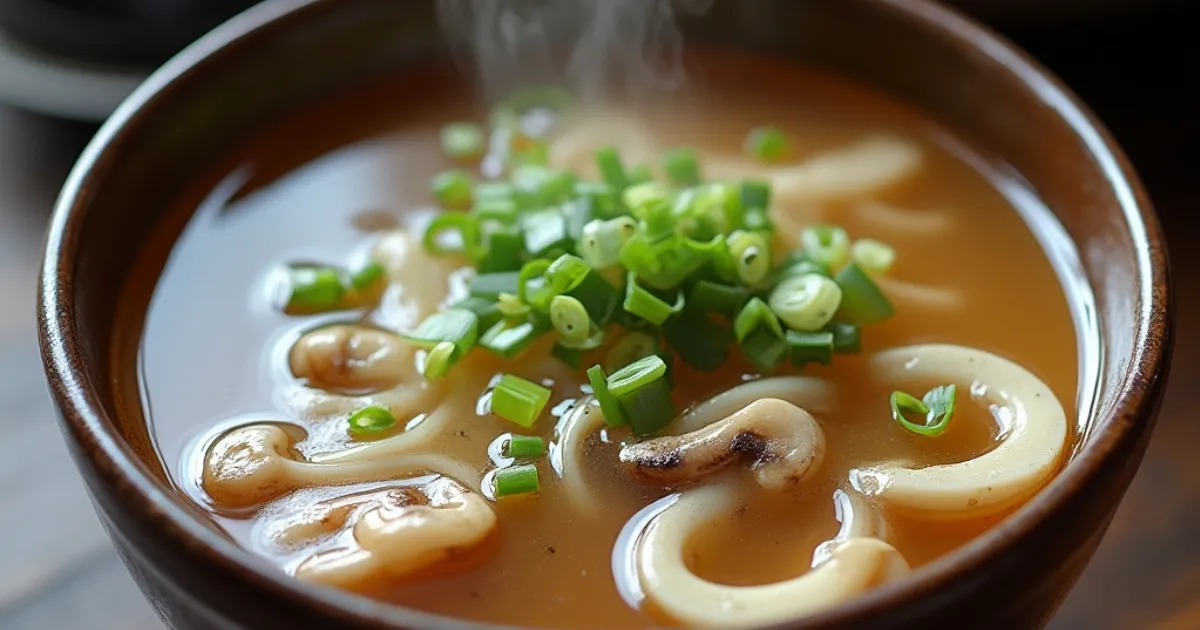Hibachi Soup Recipe: A Flavorful Japanese Classic
Introduction:
- Opening Reflection
Begin by immersing the reader in the atmosphere of a Japanese hibachi experience, where the warm aroma of simmering soup meets the sizzling excitement of the meal. - Personal Connection
Invite readers to recall their own memories of hibachi restaurants or, if they’re new to it, intrigue them with the idea of recreating this classic Japanese soup at home.
What is Hibachi Soup? A Japanese Culinary Tradition
- Brief Description of Hibachi Soup
Define hibachi soup as a clear, broth-based soup often served as a light starter in Japanese restaurants, traditionally including vegetables like mushrooms, onions, and carrots. - Cultural Background
Explain the origins of hibachi cooking in Japan, focusing on the hibachi grill experience and how hibachi soup complements the main course, making it an integral part of Japanese dining culture. - Special Ingredients that Define
Introduce ingredients like miso, dashi, or soy sauce, which contribute unique umami flavors, making hibachi soup distinct from other types of soup.
Ingredients for the Perfect Hibachi Soup Recipe
Ingredient List with Measurements
- Provide a detailed, well-organized ingredient list in a table format for quick reference. Include recommended quantities and optional add-ins to suit different tastes.
| Ingredient | Quantity | Notes |
|---|---|---|
| Chicken Broth | 4 cups | Substitute with vegetable broth for vegan |
| Onion | 1/2 medium | Roughly chopped |
| Mushroom | 1/4 cup sliced | Use shiitake or white mushrooms |
| Carrot | 1 small | Sliced thin |
| Garlic | 1 clove, minced | Adds depth to the broth |
| Soy Sauce | 1-2 tsp | For a subtle umami boost |
Step-by-Step Guide
Preparing the Ingredients
- Step 1: Chopping and Slicing
Instruct readers on the proper way to chop the onion, mushrooms, and carrot, emphasizing thin slices for quick cooking and optimal flavor extraction.
Cooking Instructions
- Step 2: Creating the Broth
- Heat a pot, add the broth, and bring to a gentle simmer. Add onion, carrot, mushrooms, and garlic, letting them simmer together for 15-20 minutes to allow the flavors to meld.
- Encourage readers to adjust flavors based on their preference (e.g., adding more soy sauce or miso for extra umami).
- Step 3: Straining the Soup
- Guide readers to strain the soup carefully, leaving a clear, fragrant broth.
- Suggest saving the vegetables for other recipes or composting to reduce waste.
Finishing Touches and Serving Suggestions
- Add garnishes like sliced green onions, crispy fried onions, or even a hint of sesame oil for added depth.
- Suggest serving hibachi soup in small bowls as an appetizer, for an authentic Japanese dining feel.
Why Hibachi Soup is Good for You: A Look at the Health Benefits
- Low-Calorie and Nutrient-Dense
Explain how is a low-calorie, nutrient-packed option that provides essential vitamins and minerals without the heaviness of cream-based soups. - Gut Health Benefits
Discuss how fermented ingredients like miso contribute to gut health, thanks to probiotics that support digestion and overall well-being. - Rich in Antioxidants
Highlight antioxidants in ingredients like garlic, onion, and mushrooms that are known for their immune-boosting properties.
Creative Variations on Traditional
Vegetarian and Vegan
- Substitute Ingredients
Recommend substituting chicken broth with vegetable broth, omitting any animal products, and adding miso for an extra depth of flavor.
Spicy Hibachi Soup
- Add a Kick of Spice
Suggest adding Sriracha, sliced chilies, or a hint of wasabi to infuse some heat, balancing the mild broth with a spicy twist.
Protein-Enhanced
- Protein Additions
For a heartier version, add cubed tofu, sliced chicken, or shrimp.
Pro Tips for the Best Hibachi Soup
- Tips for Extra Flavor
Recommend roasting the garlic or mushrooms before adding to the broth for a deeper, richer taste. - Choosing the Right Ingredients
Encourage using fresh, high-quality mushrooms and broth to enhance flavor, noting how this can make a noticeable difference.
Frequently Asked Questions (FAQ)
- Can I make hibachi soup in advance?
Yes! Hibachi soup can be prepared ahead of time and reheated, making it a great option for meal prep. - What’s the difference between hibachi soup and miso soup?
Hibachi soup is typically clear and lighter in flavor, while miso soup contains miso paste, making it cloudier and richer. - How long does hibachi soup last?
Hibachi soup can last up to 4 days when stored in an airtight container in the fridge. - Can I freeze hibachi soup?
Yes, hibachi soup freezes well for up to 3 months. It’s best to omit garnishes until you’re ready to serve.
Conclusion: Bring Japanese Comfort into Your Kitchen
- Final Thoughts
Remind readers how simple yet fulfilling hibachi soup is to make at home. Encourage them to experiment with flavors and make it their own while appreciating the soup’s roots in Japanese culinary culture. - Call-to-Action
Invite readers to try the recipe and share their experiences or any twists they put on the recipe. Suggest pairing it with other Japanese-inspired dishes for a full hibachi experience at home.

Hibachi Soup Recipe: A Flavorful Japanese Classic
Yield:
4
Prep Time:
10 minutes
Cook Time:
30 minutes
Additional Time:
40 minutes
Total Time:
40 minutes
Ingredients
- 6 cups chicken broth (or vegetable broth)
- 1 small onion, chopped
- 2 cloves garlic, minced
- 1 carrot, chopped
- 2 celery stalks, chopped
- ½ teaspoon salt (adjust to taste)
- ½ teaspoon black pepper
- 1 teaspoon soy sauce
- ½ teaspoon sesame oil (optional)
- ¼ teaspoon ground ginger (or 1-inch fresh ginger, sliced)
- ½ cup mushrooms, thinly sliced
- 2 green onions, sliced for garnish
- Fried onions or crispy shallots for topping (optional)
Instructions
- Prepare the Broth:
- In a large pot, bring the chicken broth to a gentle boil.
- Add onion, garlic, carrot, celery, salt, black pepper, soy sauce, and ginger.
- Simmer for Flavor:
- Reduce heat and let the broth simmer for 25-30 minutes.
- Skim off any foam or impurities that rise to the top.
- Strain the Soup:
- Use a fine-mesh strainer to remove the vegetables, leaving a clear broth.
- Discard the solids or save them for another recipe.
- Add Mushrooms & Final Touches:
- Return the broth to the pot and add sliced mushrooms.
- Simmer for another 5 minutes until mushrooms are tender.
- Stir in sesame oil for extra depth of flavor.
- Serve & Garnish:
- Ladle the soup into bowls and top with sliced green onions and crispy fried onions.
- Enjoy hot as an appetizer or a comforting light meal.
Notes
- For a deeper flavor, use homemade chicken broth or add a dash of dashi powder.
- Want extra spice? Add a pinch of red pepper flakes or a drizzle of chili oil.
- Make it vegetarian by using vegetable broth and skipping the chicken base.
- Storage: Keeps in the fridge for up to 4 days or freezes well for up to 3 months.

